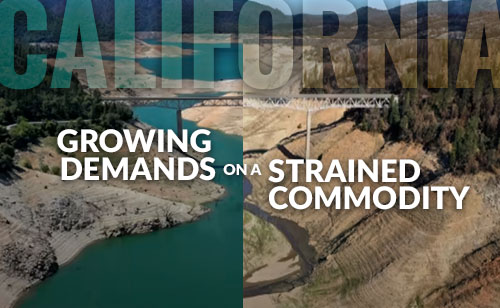
In some positive news, our country’s overall aggregate water usage has decreased over the past few decades despite our population growth. Yet, this has not changed the sobering reality that we are continuing to deplete our finite water supply. Ultimately, growing demands are being placed on an already strained commodity. Our National Sprawl Study reports:
Aggregate water use (withdrawals) in the U.S. has actually decreased in recent decades. During this same period, the U.S. population has increased by tens of millions of inhabitants. This illustrates that the relationship between population size and growth and aggregate water consumption is not a simple linear one. Every added increment of population does not necessarily equal an added increment of water consumption. 1 unit of population + 1 unit of population ≠ 2 units of water use. But nor is it true that there is no correlation at all between aggregate population size and aggregate water withdrawals and consumptive use.
In addition to population size, economic structure and level of activity, water conservation, reuse and efficiency measures all have a bearing in determining total water use in a given area or jurisdiction. For example, Idaho actually ranks third nationally in total water withdrawals, in spite of its comparatively low population (ranked 39th of 50 states in population size), because of the high amount of water it uses to irrigate crops fed to human consumers or livestock in other states and other countries. (Some of this water withdrawn for agriculture is “consumptively used”, i.e., incorporated into crops or lost to evapotranspiration, and some of it drains back to watercourses as “return flows”, often carrying salts or contaminants.)
For a period of time, and with strong public commitment and political support, total water use can actually be reduced — or at least held constant — even with a growing U.S. population, as it has been in recent decades. However, the crucial point is that under these special circumstances, if the U.S. population were stable (non-growing), aggregate water consumption could be reduced even more, were the same commitments made to water conservation, reuse and efficiency, allowing still more water to remain where it longs — in natural streams, rivers, and lakes — where it furnishes ecological benefits to habitat, wildlife, and society.
An important comment to note from above is that it will take strong public commitment. Yet, in California, a state thought to be at the forefront of environmental stewardship, the overall water usage has actually increased in numerous areas. This has occurred despite the drought conditions that have brought with it tight water restrictions. The Los Angeles Times writes:
Coastal Southern California increased water usage by more than 25% for the month of April, lagging behind most other parts of the state in conservation and appearing to dismiss dire warnings of supply shortages.
According to data released Tuesday by the State Water Resources Control Board, cities and towns in the South Coast hydrologic region — an area that includes Los Angeles and more than half the state’s population — used 25.6% more water in April than in April 2020, the first year of the current drought.
Statewide, urban residents used 17.6% more water, marking a small decline from March, but still far less than what officials say is needed to weather a historic drought…
… While the South Coast’s numbers were disheartening, the Colorado River hydrologic region in the southwestern part of the state did even worse, with a reported usage increase of nearly 41% in April…
…As it stands, California now sits in a perilous position as it heads into the hot, dry months of summer, Gleick said, with the likelihood of wildfires, dried-up wells, fallowed farmland and dead salmon all increasing along with the heat and dryness.
…The latest U.S. Drought Monitor update, published Thursday, shows about 12% of the state is now under “exceptional” drought, the worst possible category, up from 0% just three months ago.
Clearly something isn’t working to address the water usage here. The solution offered by Las Virgenes Municipal Water District, located in Southern California, might seem a bit intrusive to some. Officials from the District are more closely watching and regulating your water intake:
When fixed in place, the device slashes water flow from 30 gallons per minute to less than one gallon per minute.
Although the kitchen faucet works just fine, showers may become unsatisfactory for those accustomed to high water pressure, and lawn sprinklers become effectively nonfunctional. And that’s exactly the point.
While the need to conserve a dwindling water supply is urgent, the question must be asked: is this how we want to live? While of course doing everything possible to preserve our precious natural resources is paramount, at the same time, it seems unfair that officials are willing to time showers while also continuing to allow for an unprecedented amount of population growth through immigration policies.
Upon being elected, Governor Newsom claimed California to be a sanctuary state and continually enacts policies that further entice those who have entered the country illegally to move there. Many Congressional members, in California and across the country, are not much better.
Our Sprawl Study points out – reducing usage and conserving water can be achieved if the public commits itself to that end and that translates into political action. All of us must be committed to being more aware of our water footprint, but we also need our government to do its part to alleviate the strain on water supplies by reducing immigration to a level that would allow for our population to stabilize.
Amy Boylan is the Content Writer for NumbersUSA’s Sustainability Initiative